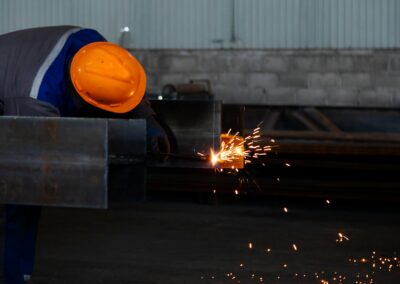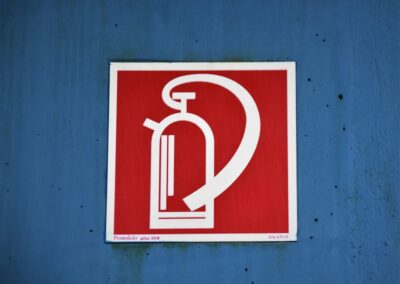Leveraging IoT Technology for Real-Time Worker Safety Compliance
The Critical Role of IoT Worker Safety Tracking in Modern Industries
The integration of IoT Worker Safety Tracking systems into industrial environments is revolutionizing how companies ensure compliance with safety protocols. In regions like Saudi Arabia and the UAE, where industries are rapidly advancing and expanding, the importance of maintaining high safety standards is paramount. IoT technology offers a cutting-edge solution by providing real-time tracking of worker location and activity, ensuring that safety protocols are not only followed but also documented for compliance purposes. This technology is particularly valuable in high-risk environments such as construction sites, manufacturing plants, and oil and gas facilities, where the safety of workers is a top priority.
By using IoT-enabled devices, companies can monitor the exact location of each worker and track their movements throughout the workday. This real-time data allows safety managers to ensure that workers are not entering hazardous areas without proper authorization or protective gear. Additionally, the data collected can be used to analyze patterns and identify potential risks before they result in accidents, making the workplace safer for everyone involved.
Ensuring Compliance and Reducing Risks with Real-Time Monitoring
One of the most significant advantages of IoT Worker Safety Tracking is its ability to ensure compliance with safety protocols in real-time. Traditional methods of monitoring worker safety often rely on periodic checks and manual reporting, which can leave gaps in compliance and increase the risk of accidents. In contrast, IoT technology provides continuous monitoring, offering a more comprehensive and accurate view of worker safety.
For example, in a manufacturing facility in Dubai, IoT devices can be used to monitor whether workers are wearing the required safety equipment, such as helmets and gloves, and whether they are following designated safety routes. If a worker deviates from the approved path or fails to wear the necessary gear, the system can immediately alert safety managers, allowing them to take corrective action before an accident occurs. This proactive approach not only enhances compliance but also reduces the likelihood of workplace injuries, contributing to a safer and more efficient working environment.
Enhancing Worker Accountability and Safety Culture
IoT Worker Safety Tracking also plays a crucial role in fostering a culture of safety and accountability within the workplace. By providing transparent and real-time data on worker activities, IoT technology encourages employees to adhere strictly to safety protocols, knowing that their compliance is being monitored. This heightened sense of accountability can lead to a significant reduction in unsafe behaviors and practices.
In regions like Riyadh, where industrial growth is accompanied by an increased focus on worker safety, IoT-based tracking systems can serve as a valuable tool in promoting a safety-first mindset among employees. By making safety data readily available to both workers and management, companies can create a more collaborative approach to safety, where everyone is involved in identifying and mitigating risks. This not only enhances individual accountability but also strengthens the overall safety culture within the organization.
Strategic Benefits of IoT-Driven Worker Safety Solutions
Improving Operational Efficiency and Reducing Costs
The strategic implementation of IoT Worker Safety Tracking systems offers numerous benefits beyond just ensuring compliance and safety. One of the key advantages is the potential to improve operational efficiency and reduce costs. By continuously monitoring worker location and activity, companies can optimize workflows and ensure that resources are being used effectively. For instance, IoT data can reveal if certain areas of a facility are consistently underutilized or if workers are spending too much time in non-productive areas.
In addition, the ability to detect and prevent safety violations in real-time can lead to a significant reduction in the costs associated with workplace accidents, such as medical expenses, legal fees, and downtime. In competitive markets like the UAE, where companies are constantly seeking ways to improve efficiency and reduce costs, the adoption of IoT-driven safety solutions can provide a significant competitive advantage.
Supporting Continuous Improvement and Innovation
IoT Worker Safety Tracking systems also support continuous improvement and innovation within the workplace. By providing detailed analytics on worker behavior and safety compliance, these systems offer valuable insights that can be used to refine safety protocols and enhance overall workplace safety. In industries where innovation is a key driver of success, such as in Dubai’s rapidly growing technology sector, the ability to continuously improve safety practices is crucial.
For example, if IoT data reveals that certain safety protocols are consistently being violated, companies can use this information to revise their training programs or implement new technologies to address the issue. This continuous feedback loop ensures that safety protocols remain relevant and effective, keeping pace with the evolving needs of the workplace.
Conclusion: The Future of Workplace Safety with IoT Technology
In conclusion, the adoption of IoT Worker Safety Tracking systems is transforming how companies ensure compliance with safety protocols and protect their workers. By leveraging real-time data and advanced analytics, businesses in Saudi Arabia, the UAE, and beyond can enhance their safety practices, reduce risks, and foster a culture of accountability and continuous improvement. As IoT technology continues to evolve, its role in workplace safety will become increasingly central to achieving operational excellence and maintaining a competitive edge in a rapidly changing global market. Companies that invest in IoT-driven safety solutions will be well-positioned to lead the way in creating safer, more efficient workplaces for their employees.
—
#IoTWorkerSafety #WorkplaceSafety #RealTimeMonitoring #SafetyCompliance #IndustrialIoT #OperationalEfficiency #ContinuousImprovement #BusinessInnovation































